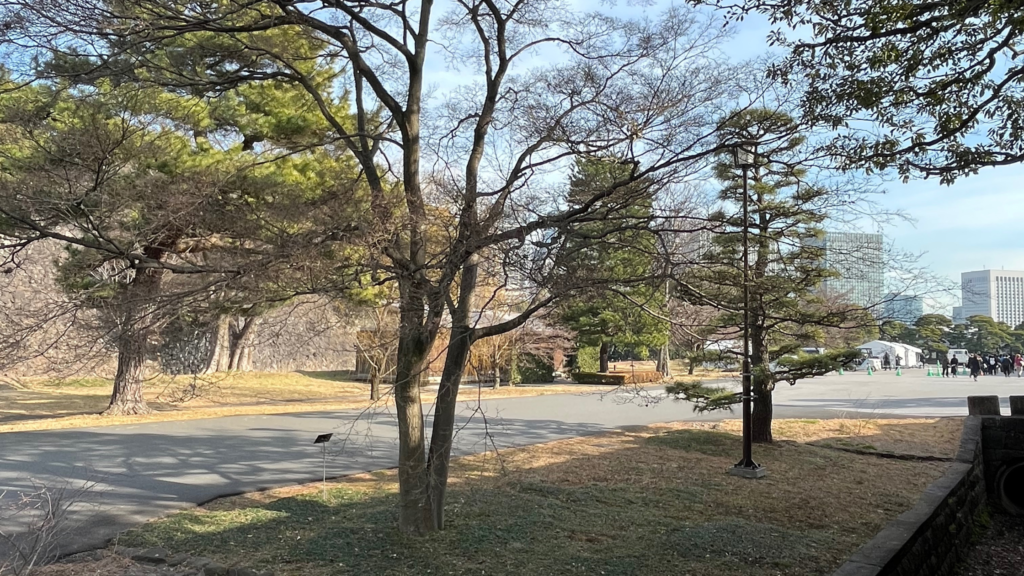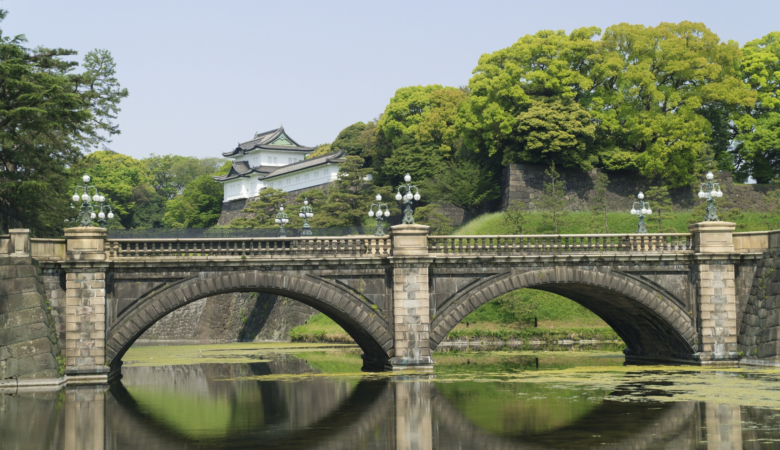The Imperial Palace is one of the most popular tourist spots as a captivating blend of history, nature, and regal splendor in Tokyo, visited by many tourists from Japan and abroad. The Imperial Palace is still the residence of His Majesty the Emperor, but until the 1868, it was the residence of the shogun of the Tokugawa shogunate. As you step into this majestic realm, let your imagination soar as we unravel its secrets. Whether you’re a history buff, a nature lover, or simply curious, the Imperial Palace promises an unforgettable experience.

Spread across 115 acres, the Imperial Palace is a sprawling oasis. Lush gardens, serene moats, and massive stone walls encircle this regal haven. As you explore, let the whispers of centuries past guide your steps. Now, I would like to introduce how to visit this large Imperial Palace.
How do we get there?
Around the Imperial Palace is dotted with Tokyo Station and several subway stations. If you visit from Sakuradamon Station, Kasumigaseki Station, Hibiya Station, or Nijubashi Station, you can quickly reach the Nijubashi where a photographer’s delight.
If you are participating in an Imperial Palace guide tour that requires a numbered ticket, Kikyo Gate is the start, so Otemachi Station will be nearby.

How do I get into the Imperial Palace?
There are places in the Imperial Palace where you can visit for free at any time, and there are places where you need a numbered ticket. Please check the map from here.

You can visit the Sakurada Gate and the Nijubashi Bridge at any time freely without a numbered ticket.

The East Garden is open from 9 a.m. to 6 p.m., except on Mondays, Fridays, and designated holidays. (Closing time is subject to change depending on the season)
There is a photo spot on the Sakuradamon side to take pictures of the Nijubashi bridge, the main gate, and the contrast with the city buildings.

If you like a history and want to freely explore the ruins of the old Edo Castle, the last residence of the Tokugawa shogunate and the Japan garden, you can see it without a numbered ticket.

What is a numbered ticket tour?
In this area, a tour guide from the Imperial Household Agency will spend one hour touring from the Imperial Household Agency, the East Gort of the Palace, the main gate of the Imperial Gate, and Yamashita Street, which is famous for cherry blossoms, in groups of each language. It is a popular tour because it is a place that you cannot usually enter, so there are many people who want to go there at least once. map
How to get a numbered ticket
This tour, which takes place twice a day (9:00am and 1:00pm), can accommodate 200 people with advance booking each time. Advance reservations will be made at 5 a.m. on the first day of each month, one month before the visit date. Please check the detail from here.
If you were unable to make a reservation, only 300 people can get a numbered ticket on the day, so why not give it a try? However, it is very popular, so you need to go about 1 hour before the numbered ticket distribution.
In addition, a limited area is open to the public for a limited time during the cherry blossom season in spring and autumn leaves, so there are times when you can enter without a numbered ticket, so please check the Imperial Palace open schedule.
Let’s enter!
You can enter the Imperial Palace from 30 minutes before the start time of the tour. You will be required to show your ID, so please be sure to bring your passport.

Once inside, from Kikyomon gate, you will be inspected and escorted to the waiting room. In the waiting room, there is a shop where you can buy souvenirs that can only be bought here, vending machines and toilets.
You will not be allowed to buy drinks or go to the restroom during the tour. Due to security reasons, you will not be able to leave in the middle, so please be sure to prepare in advance. Also, the shop is closed after started the tour, so if you wanted to buy souvenirs, please buy them before the tour.

Until the tour start time, the guide will give you an explanation about the overall experience and history of the Imperial Palace, and then the tour will start with groups in different languages.
At first, look at the Fujimi Tower on your right and proceed to the east garden of the palace. The Fujimi Tower was rebuilt two years after it was destroyed by fire in 1657 and is a valuable building that still exists in the main building of Edo Castle.

Next is the Imperial Household Agency. The Imperial Household Agency was built in 1935 and was used as a temporary palace until the palace was built.

The East Cort of the Palace is a place where members of the Imperial Family come out to greet each other on New Year’s Day and the Emperor’s Birthday. In front of this terrace can accommodate 2,000 people.

Next is the main gate iron bridge. Standing on the bridge where you can see the outside without a numbered ticket, you can see the skyscrapers. This will be the turning point of this tour.

On the way back, go through Yamashita Street, where greenery and various flowers bloom, and return to Kikyo Gate.

Finally, return the badge and you’re done.
Summary
The Imperial Palace is a very large area, and there are areas where you can see freely and areas that require numbered tickets.
If you wanted to participate in the Imperial Household Agency guided tour, you need to get a numbered ticket. In that case, it will take about one and a half hours. If you wanted to see the Nijubashi bridge or see the ruins of Edo Castle only, you can go around freely without a numbered ticket.
You can choose a method of getting around the Imperial Palace that suits your tastes.
There is also a shop in the East Garden, so you can buy original goods. (Please note that not all of them are the same.)
If you would like to see not only the large gardens of the Imperial Palace but also the inside of the palace, we recommend visiting the Akasaka Palace State Guest House. This was once used as the residence of His Majesty the Emperor and is currently used as a place to entertain state guests from overseas. The inside of the palace is a neo-baroque building with great decoration. The fountain in the garden is also spectacular.

Please come and visit places where you can experience Japanese history and culture.

